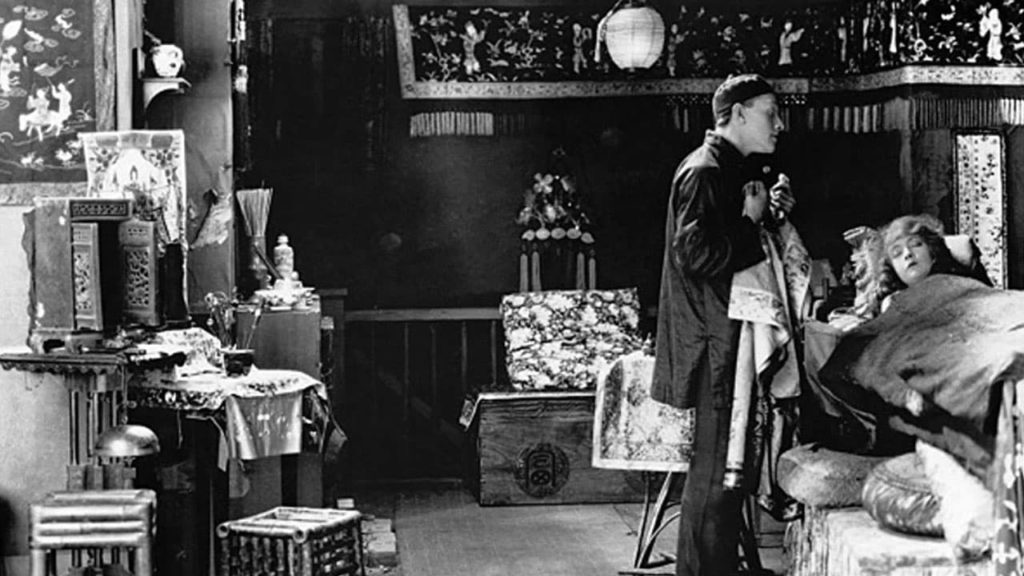DW Griffith, the premier American epic filmmaker of the 1910s, had his biggest financial stumble in the hugely ambitious, 3.5-hour Intolerance. His production company crumbled, and so Griffith was subsequently limited to creating smaller pieces shot on studio sets. He kicked off this later phase of his career with Broken Blossoms, a bleak and subdued romance between a battered daughter of a boxer and a Chinese immigrant.
Intolerance had showcased Griffith’s ascending skill at emotive close-ups and coaxing incredible acting from his stars. While Intolerance was too sweeping in scope and spectacle to fully pay off emotionally, Broken Blossoms displays that personal, evocative cinematic language in full force.

The story centers around a Buddhist named “The Yellow Man” — an honorable, but still alien, immigrant from China and local shop-owner. The heavily stereotyped and caricatured Yellow Man (played, unfortunately, by a squinting white man, Richard Barthelmess) observes his neighborhood from a detached distance in a lonely, opium-addled stupor. Meanwhile, the vicious, alcoholic boxer, called Battling Burrows (Donald Crisp), has a daughter named Lucy (Lillian Gish), whom he beats and orders around.
The Yellow Man holds a soft spot in his heart for Lucy, and when she appears in his shop after a particularly brutal beating from her father, he nurses her back to health with gentleness. The two share moments of tenderness, but when they seem to be drawing in for a kiss, he pulls away and kisses her sleeve instead. Interracial love was both a crime and a scandal in 1919, after all.
Battling Burrows eventually discovers Lucy is staying with The Yellow Man, and he brings her home. She flees to a closet at her father’s threats. Then, in easily the most harrowing segment of the film, Battling Burrows grabs a hatchet and busts down the closet door as we see Lucy in an extended, heart-rending panic. Battling Burrows finally breaks in, pulls Lucy out, and beats her to death. The Yellow Man discovers this and shoots and kills Battling Burrows as the movie concludes.

Broken Blossoms, while a minor and restrained piece of melodrama, greatly benefits from narrative focus (in comparison to Griffith’s Intolerance and The Birth of a Nation). We get to know the three main characters very well, and all benefit from excellent acting. This gives the films pivotal moments — the held back kiss, the closet scene — great impact. Gish, in particular, is magnetic on screen. Her shift from sweet naivete to terror is always a gut punch.
Griffith’s clear sense of how to visually construct and assemble a narrative is retained, even enhanced, from his larger epics. Sophisticated use of cross-cutting and varying shot types allows the story to flow, often with tension between alternating scenarios (e.g. a gentle bedside encounter vs. a brutal boxing match). His camera, though moving only occasionally, is masterfully used, particularly in close-ups and during a thrilling boxing match.
Given the small scope, Griffith and his team also construct a very compelling and tactile setting. Much of this is atmospheric: we can feel the dustiness of the shops, the murkiness of the opium den, and the fogginess of the streets (the latter filmed as a beautiful contrast to Lucy’s bright, clear face). The sense of physical space is astonishing, particularly the dingy apartment and bedroom above he shop.

Broken Blossoms certainly contains some problematic storytelling; yet, from the creator of The Birth of a Nation, this film feels downright progressive, just a product of its age. The Yellow Man is a racist caricature played by a yellow-faced white man, yet the film treats him with dignity and humility, with constant reminders that all of us are just human. An opening, humanizing segment set in China grounds him from the start, so we see him as more than the broad racist strokes that the film otherwise uses.
(It’s also worth nothing that there are a few cues that Lucy might be well under the age of 18, which would entirely reframe our modern take on this romance, though her age is left unclear, and Lillian Gish was 26 and certainly looks like an adult.)
The film’s most melodramatic moments often feel emotionally manipulative. Griffith leans heavily on our sympathy towards the charismatic Gish as Lucy for impact, piling on her suffering in scene after scene. For me, the tone of tragedy was forecasted from start to finish, so I never felt cheated into a cheap cry: Danger always loomed around the corner, particularly in Donald Crisp’s terrifying turn as a violent father.
Last complaint: The copy I saw was thoroughly grainy and damaged. I’d love to watch a cleaner cut if it exists.

Overall, I found this the most watchable of Griffith’s films I’ve seen. The story’s focus and the atmospheric setting, brought to life by phenomenal editing and camera work, help it stand the test of time. It has clear and compelling characters and story, even if its story is rooted in 1919 cultural mores.
And that closet scene. Goddamn.
(I’m attempting to watch 1001 Films to See Before Your Die in chronological order. This is film number 7. Up next is the 1920 film Within Our Gates, among the first features directed by a Black person.)
Is It Good?
Good (5/8)
A few words on "Is It Good?" ratings for early cinema.
Follow Dan on Letterboxd or Twitter. Join the Discord for updates and discussion.

